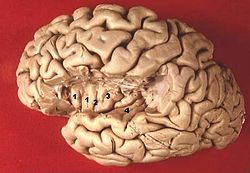| Transverse temporal gyrus | |
|---|---|
 Section of brain showing upper surface of temporal lobe ("transverse temporal gyri" visible at center left) | |
 Human brain view on transverse temporal and insular gyri (gyri temporales transversi are #4) | |
| Details | |
| Part of | Temporal lobe |
| Parts | Primary auditory cortex |
| Artery | Middle cerebral |
| Identifiers | |
| Latin | gyri temporales transversi |
| NeuroNames | 1520 |
| TA98 | A14.1.09.140 |
| TA2 | 5491 |
| FMA | 72016 |
| Anatomical terms of neuroanatomy | |
The transverse temporal gyrus, also called Heschl's gyrus (/ˈhɛʃəlz ˈdʒaɪraɪ/) or Heschl's convolutions, is a gyrus found in the area of each primary auditory cortex buried within the lateral sulcus of the human brain, occupying Brodmann areas 41 and 42. Transverse temporal gyri are superior to and separated from the planum temporale (cortex involved in language production) by Heschl's sulcus. Transverse temporal gyri are found in varying numbers in both the right and left hemispheres of the brain and one study found that this number is not related to the hemisphere or dominance of hemisphere studied in subjects.[citation needed] Transverse temporal gyri can be viewed in the sagittal plane as either an omega shape (if one gyrus is present) or a heart shape (if two gyri and a sulcus are present).[1]
Transverse temporal gyri are the first cortical structures to process incoming auditory information. Anatomically, the transverse temporal gyri are distinct in that they run mediolaterally (toward the center of the brain), rather than front to back as all other temporal lobe gyri run.
The Heschl's gyri are named after Richard L. Heschl.
- ^ Yousry TA, Fesl G, Buttner A, Noachtar S, Schmid UD (1997). "Heschl's gyrus-Anatomic description and methods of identification on magnetic resonance imaging" (PDF). Int J Neuroradiol. 3 (1): 2–12.